Welcome to our blog
Keep up with our latest demographic insights

Results from the National Assessment of Student Progress (NAEP), known also as the Nation’s Report Card, have been getting a lot of attention over the past month. The US Secretary of Education has called the results “unacceptable.” North Carolina’s Superintendent, Catherine Truitt, said the results were unsurprising, given the COVID-19 impact on K-12 learning in the state. What did the results show? National 2022 test scores showed an average decline of 5 points in reading…

With myFutureNC, we have released the 2022 County Attainment Profiles which highlights specific opportunities for improvement that will ultimately lead to increased attainment. The profiles highlight each of North Carolina’s 100 counties’ educational attainment levels and performance on key myFutureNC metrics in order to assist in the decision-making process regarding local priorities to increase educational attainment at the local level. There is also an overall 2022 attainment profile for the state. Each 2022 County Attainment…
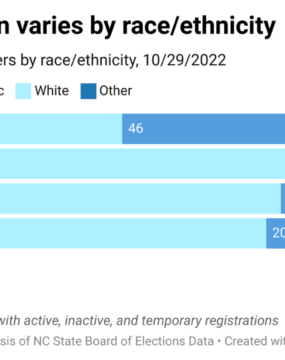
As of October 29th, 2022, North Carolina had about 7.4 million registered voters. Their partisan affiliation was roughly split between three groups: Democrat, unaffiliated, and Republican, with a slight lead to unaffiliated voters. Specifically: 2,495,097 or 34% were registered Democrat; 2,637,581 or 36% were registered Unaffiliated; 2,221,179 or 30% were registered Republican; and 50,511 or 0.7% were registered to another party. Other party registrations included Libertarian (50,272 or 0.7%) and Green Party (239 or 0.0%).…
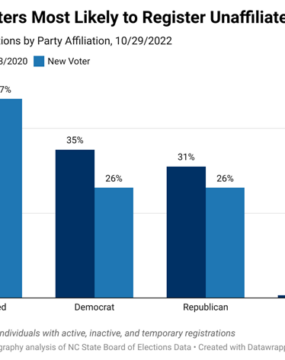
As early voting for the 2022 midterm elections are underway, there have been demographic shifts in North Carolina since the 2020 general elections. With election day coming soon, we’ve broken down the changes by partisan composition and who makes up our newly registered voting population based on voter registration data as of October 29, 2022. First, we should note: our state’s population continues to grow North Carolina has experienced steady population gains since 2020, with net…
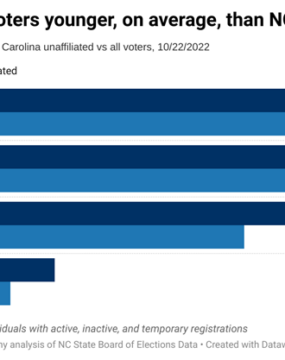
This is part of our series looking at NC’s registered voters. Other stories include an in-depth look at NC's Republican voters and an in-depth look at NC's Democratic voters. This is an update of our 2020 piece. As of October 22nd, 2022, North Carolina had 7.4 million registered voters. Of these, 2.6 million or 35.5% were registered unaffiliated. This post examines the characteristics of NC’s unaffiliated voters. Age Younger voters are the most likely to…
This is part of our series looking at NC's registered voters. Other stories include an in-depth look at NC's Democrat voters and an in-depth look at NC's unaffiliated voters. This is an update of our story from August 2020. As of October 22nd, 2022, North Carolina had 7.4 million registered voters. Of these, 2.2 million or 30% were registered as a Republican. Age Younger voters are the least likely to register as Republican, reflecting their…
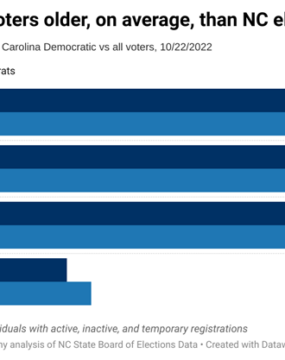
This is part of our series looking at NC's registered voters. Other stories include an in-depth look at NC's Republican voters and an in-depth look at NC's unaffiliated voters. This is an update of our story from August 2020. As of October 22nd, 2022, North Carolina had 7.4 million registered voters. Of these, 2.5 million or 33.75% were registered as a Democrat. Age Older voters are the most likely to register as a Democrat, partly…

We're looking for a new director to lead Carolina Demography! (Job posting here.) Carolina Demography is a demographic research unit sitting within the Carolina Population Center at UNC-Chapel Hill. We translate demographic knowledge into specific usable information to help people throughout North Carolina understand the implications of demographic change. What you'll do You will: Provide direction and oversight to the Carolina Demography unit at the Carolina Population Center. Solicit, manage, and oversee the performance of…

Dr. Michael Cline is the state demographer for North Carolina at the Office of State Budget and Management and has given us permission to re-post his content here. Each year, he publishes population estimates and projections for North Carolina and its counties. It’s a time of excitement for thousands of 5-year-olds (and their parents) in North Carolina. As a new school year begins, many of these children will start kindergarten. According to current OSBM projections,…
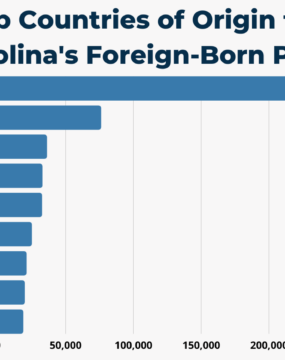
Dr. Michael Cline is the state demographer for North Carolina at the Office of State Budget and Management and has given us permission to re-post his content here. Each year, he publishes population estimates and projections for North Carolina and its counties. Miguel came to North Carolina from Columbia when he was a little boy, not yet old enough for school. While many of his family members still live in Columbia, North Carolina is the…
Your support is critical to our mission of measuring, understanding, and predicting population change and its impact. Donate to Carolina Demography today.